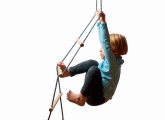In picture books anything is possible, and that makes them ideal for inspiring creative activities for your children, says Alison Davies…
In the world of picture books everything can be exaggerated, from the flamboyant use of images to nonsensical rhymes. The content doesn’t have to make sense in the real world. This is because the book is a trigger for the imagination. It’s like taking a trip in Dr Who’s TARDIS – you don’t know what you’ll find until you get there, but you’re guaranteed to have an enjoyable ride and experience some surprises along the way.
Some adults feel that picture books should be all about learning, but this happens to be a by product of what they’re really about: stimulating children’s creativity. When you provide a child with a story setting and then back it up with vivid pictures and fun language, you’re giving them the key to the TARDIS. From there they can go anywhere and learn any number of things!
When it comes to using picture books in your setting, embrace the absurd and let it spark imaginations. The more ridiculous the content, the more potential there is to learn, because the book is open for interpretation, leaving children to take the lead. The sillier the story, the more fun you’ll have exploring the pages, and there’s certain to be lots of scope for follow on activities.
This gorgeous picture book by Nick Sharratt is a fantastic storytelling tool. With see-through pages that allow children to guess what’s coming next, and some wonderful rhyming phrases, you’ll be surprised at the strange delights you find lurking in the foggy forest…
For every page and shadowy shape the book asks, ‘What could this be in the foggy, foggy forest?’ As you turn each page the answer is revealed: “An ogre doing yoga”, or “a unicorn blowing a horn”. Come up with sounds and actions for each answer and encourage the children to join in. Once they’ve got to grips with each movement, mix it up and change the order that they appear in the story. Take the actions on the move. Lead a trail in a circle, moving as characters in the story. So you might say “How does an ogre move through the forest?” Or “How does a fairy princess move on a trampoline?” Get the children jumping, skipping and crawling!
Turn the space you have into a forest. Create shadowy trees and patches of undergrowth using cushions and mats. Give each child the shape of a creature that might be lurking in the forest. Ask them to colour in the picture and guess what the creature might be. Take this a step further by asking them to draw a creature that might live in the forest. Take some time at the end of the session so that each child can share their ideas with the rest of the group. Encourage them to describe their creation – what does it look like, what sound does it make, how does it move, what does it eat and where might it live in the forest?
This activity requires some preparation, but it’s definitely worth it! Collect together pictures of characters from books or fairy tales. Next gather pictures of objects that the children are familiar with, for example, a bath or a bicycle. Put the characters in one box and the objects in another. Read the book together and then split the children into smaller groups or pairs. Tell them that they’re going to write their own foggy, foggy forest book by picking out characters and objects, and then putting them together in a picture and adding words. For example, they might pick Humpty Dumpty and a toothbrush, so they might decide to draw a picture of him brushing his teeth, or scratching his back with it!
Next they need to come up with a few words in answer to the question ‘What could this be in the foggy, foggy forest?’ So they might say “Humpty brushing his teeth, sat on a leaf”. Encourage them to share their ideas by chanting the question as a group, so that they can reveal their answer.
This charming book by Eric Carle is about a father trying to catch the moon for his daughter. It’s an impossible task that captures the magic of the moon and the way it changes shape in the sky.
Once you’ve read the book encourage little ones to become the moon and chart its journey. Starting as a tiny ball they should slowly growing in size until they’re up on tiptoes, with their hands and arms out- stretched to make the full moon. Then, gradually, they become small again until they disappear from the sky. Put the whole thing to music to create a moon dance!
Ask the children to draw the moon in its different phases and decorate each one with patterns and shapes, then attach them to string and hang from the ceiling. Use glitter to create stars and space rockets that you can hang at different levels for a space age effect!

Boost children’s confidence by letting them try
Editors picks

5 Ways to Use Tech in the Early Years Classroom
Editors picks
